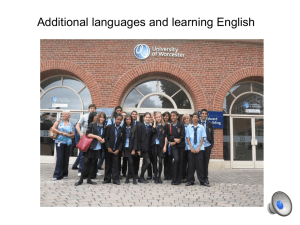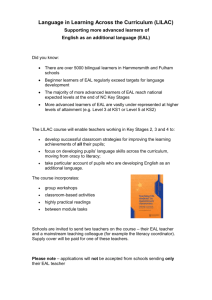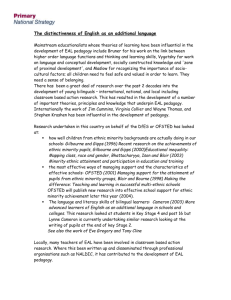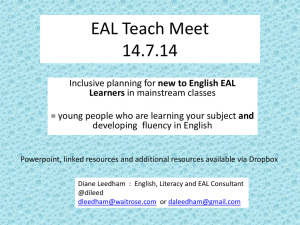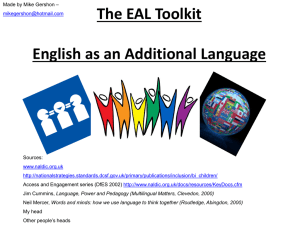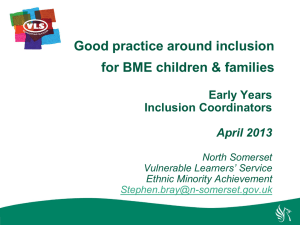here - School of Education - Oxford Brookes University
advertisement
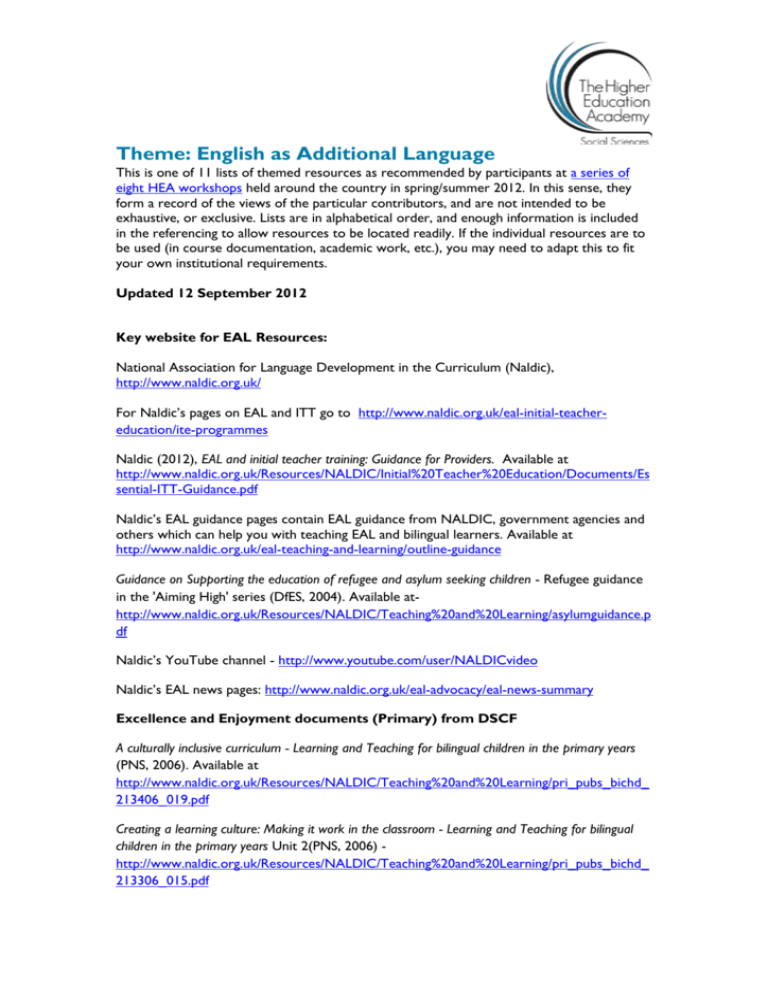
Theme: English as Additional Language
This is one of 11 lists of themed resources as recommended by participants at a series of
eight HEA workshops held around the country in spring/summer 2012. In this sense, they
form a record of the views of the particular contributors, and are not intended to be
exhaustive, or exclusive. Lists are in alphabetical order, and enough information is included
in the referencing to allow resources to be located readily. If the individual resources are to
be used (in course documentation, academic work, etc.), you may need to adapt this to fit
your own institutional requirements.
Updated 12 September 2012
Key website for EAL Resources:
National Association for Language Development in the Curriculum (Naldic),
http://www.naldic.org.uk/
For Naldic’s pages on EAL and ITT go to http://www.naldic.org.uk/eal-initial-teachereducation/ite-programmes
Naldic (2012), EAL and initial teacher training: Guidance for Providers. Available at
http://www.naldic.org.uk/Resources/NALDIC/Initial%20Teacher%20Education/Documents/Es
sential-ITT-Guidance.pdf
Naldic’s EAL guidance pages contain EAL guidance from NALDIC, government agencies and
others which can help you with teaching EAL and bilingual learners. Available at
http://www.naldic.org.uk/eal-teaching-and-learning/outline-guidance
Guidance on Supporting the education of refugee and asylum seeking children - Refugee guidance
in the 'Aiming High' series (DfES, 2004). Available athttp://www.naldic.org.uk/Resources/NALDIC/Teaching%20and%20Learning/asylumguidance.p
df
Naldic’s YouTube channel - http://www.youtube.com/user/NALDICvideo
Naldic’s EAL news pages: http://www.naldic.org.uk/eal-advocacy/eal-news-summary
Excellence and Enjoyment documents (Primary) from DSCF
A culturally inclusive curriculum - Learning and Teaching for bilingual children in the primary years
(PNS, 2006). Available at
http://www.naldic.org.uk/Resources/NALDIC/Teaching%20and%20Learning/pri_pubs_bichd_
213406_019.pdf
Creating a learning culture: Making it work in the classroom - Learning and Teaching for bilingual
children in the primary years Unit 2(PNS, 2006) http://www.naldic.org.uk/Resources/NALDIC/Teaching%20and%20Learning/pri_pubs_bichd_
213306_015.pdf
Creating an inclusive learning culture - Learning and Teaching for bilingual children in the primary
years Unit 3(PNS, 2006) http://www.naldic.org.uk/Resources/NALDIC/Teaching%20and%20Learning/pri_pubs_bichd_
213306_015.pdf
Culture and identity:ethos,environment and curriculum - Learning and Teaching for bilingual children
in the primary years PDM 7 (PNS, 2006) http://www.naldic.org.uk/Resources/NALDIC/Teaching%20and%20Learning/pri_pubs_bichd_
214206_011.pdf
Day-to-day assessment - Learning and Teaching for bilingual children in the primary years PDM
6(PNS, 2006) http://www.naldic.org.uk/Resources/NALDIC/Teaching%20and%20Learning/pri_pubs_bichd_
214106_010.pdf
Developing learning partnerships with parents, carers and families - Learning and Teaching for
bilingual children in the primary years PDM 8(PNS, 2006) communities http://www.naldic.org.uk/Resources/NALDIC/Teaching%20and%20Learning/pri_pubs_bichd_
214306_012.pdf
EAL principles, pedagogy and practice: first language as a tool for learning - Learning and Teaching
for bilingual children in the primary years PDM 2(PNS, 2006)
http://www.naldic.org.uk/Resources/NALDIC/Teaching%20and%20Learning/pri_pubs_bichd_
213706_06.pdf
Development Matters in the Early Years Foundation Stage - This non-statutory guidance material
supports practitioners to implement the statutory requirements of the EYFS. Contains many
references to EAL and home languages http://www.naldic.org.uk/Resources/NALDIC/Teaching%20and%20Learning/Development%2
0Matters%20FINAL%20PRINT%20AMENDED.pdf
Classroom Assessment of English as an Additional Language: Key Stage 1 Contexts - ERSC funded
research into assessment in primary contexts http://www.naldic.org.uk/Resources/NALDIC/Teaching%20and%20Learning/classroomassessr
eport.pdf
Access and engagement documents (Secondary) from DSCF
The twelve Access and Engagement documents (each one covering a different curriculum
subject) from the DCSF to be found on through the following link are highly recommended.
Art:
http://www.naldic.org.uk/Resources/NALDIC/Teaching%20and%20Learning/sec_ks3_en_acc
ess_engage_art.pdf
Design and Technology:
http://www.naldic.org.uk/Resources/NALDIC/Teaching%20and%20Learning/en_eal_access_e
ngagement_dt.pdf
English:
http://www.naldic.org.uk/Resources/NALDIC/Teaching%20and%20Learning/ks3_en_eal_acce
ss_engagement.pdf
Review: This is a substantial document which aims to enable teachers to integrate learners of EAL
into KS 3 Strategy English lessons, both "to develop their understanding and use of the English
language" and "to enhance their learning in English lessons." The document is divided into two
sections, one aimed at supporting subject leaders in providing guidance to their department. This
section is based on current research (although the references are not given) and focuses on certain
key issues such as the development of academic language, the use of first language and the
importance of flexible groupings in the classroom. The second part of the document provides
teaching strategies which focus on planning for the different range of needs of pupils at different
stages of learning English. The document is a useful for ensuring that trainees are aware of the
range of different classroom situations they may encounter and of the range of strategies available
for differentiation. The document has been found to be useful by teachers of all subjects.
Geography:
http://www.naldic.org.uk/Resources/NALDIC/Teaching%20and%20Learning/sec_ks3_ge_acce
ss_engage_eal.pdf
History:
http://www.naldic.org.uk/Resources/NALDIC/Teaching%20and%20Learning/sec_ks3_hi_eal_
access_engage.pdf
ICT:
http://www.naldic.org.uk/Resources/NALDIC/Teaching%20and%20Learning/06112002ICT.pdf
Review: This document aims to enable teachers to ensure that learners of EAL have full access to
KS 3 ICT lessons. The document is very similar to the guidance document for English. It is divided
into two sections, one aimed at supporting subject leaders in providing guidance to their department.
This section is based on current research (although the references are not given) and focuses on
certain key issues such as the development of academic language, the use of first language and the
importance of flexible groupings in the classroom. The second part advises teachers on creating a
supportive learning environment in the mainstream classroom and on planning for the different
range of needs of pupils at different stages of learning English. The document is of value for
ensuring that trainee teachers are aware of the range of different classroom situations they may
encounter and of the range of strategies available for differentiation. However the advice is very
generic and there is little mention of the rich possibilities of ICT for developing the use of first
languages in the classroom.
Mathematics:
http://www.naldic.org.uk/Resources/NALDIC/Teaching%20and%20Learning/ma_eal.pdf
Review: This document is aimed at subject leaders and classroom teachers to support them in
making Mathematics lessons accessible to learners of EAL. The document has a strong focus on the
importance of talk in making mathematics accessible to EAL learners. A section on reading and
writing in mathematics notes the importance of modelling the very different types of text used in
mathematics and the very specific skills they require. There is a strong focus in the booklet on the
development of vocabulary and less of a focus on making meaning in mathematics. The document
provides a range of strategies to support trainee teachers in making mathematics lessons accessible
to learners of EAL.
Modern Languages:
http://www.naldic.org.uk/Resources/NALDIC/Teaching%20and%20Learning/sec_eal_mfl_acc
ess_engage.pdf
Music:
http://www.naldic.org.uk/Resources/NALDIC/Teaching%20and%20Learning/sec_mus_eal_ac
cess_engag.pdf
Physical Education:
http://www.naldic.org.uk/Resources/NALDIC/Teaching%20and%20Learning/sec_pe_eal_acce
ss_engag.pdf
Religious Education:
http://www.naldic.org.uk/Resources/NALDIC/Teaching%20and%20Learning/sec_re_eal_acce
ss_engagRE.pdf
Science:
http://www.naldic.org.uk/Resources/NALDIC/Teaching%20and%20Learning/06102002Science.pdf
Review: This document is aimed at subject leaders and classroom teachers to support them in
making Science lessons accessible to learners of EAL. The document is divided into two sections, the
first aimed at supporting subject leaders in providing guidance to their department. This section is
broadly based on current research (although references are not given). It has a strong focus on
"models as concrete representations of abstract ideas and complex relationships". The second
section contains practical guidance for teachers and classroom examples. The document is very
strongly focused on issues of language, and vocabulary, development in particular. The document is
useful for ensuring that trainee teachers are aware of the complexity of the language learning
process in science and in providing strategies.
Review of the other Access and Engagement documents (MFL, Music, Art, P.E., R.E., History,
Geography, Design and Technology): Each document covers one area of the curriculum at KS3.
All aim to enable teachers to integrate learners of EAL into all subject lessons, both "to develop their
understanding and use of the English language" and "to enhance their learning in... the appropriate
subject". Each document is divided into two sections, the first one aimed at supporting subject
leaders in providing guidance to their department. This section is based on current research
(although the references are only provided in the MFL document) and focuses on certain key issues
such as the development of academic language, the use of first language and the importance of
flexible groupings in the classroom. The second part of the document provides teaching strategies
which focus on planning for the different range of needs of pupils at different stages of learning
English in the mainstream classroom. The documents are all very similar in structure and in the
advice provided. The MFL guidance is the only one that provides substantial examples of practice; it
also draws out the similarities in FLE and EAL pedagogy. The documents are useful tools for
ensuring that trainee teachers are aware of the range of different classroom situations they may
encounter and of the range of strategies available for differentiation.
Reviews contributed by Dr Raymonde Sneddon.
NALDIC (last updated 2011) Bilingualism and Second Language Acquisition. Available at
http://www.naldic.org.uk/eal-initial-teacher-education/resources/ite-archive-bilingualism.
Grammar for writing: supporting pupils learning EAL - Guidance for secondary EAL teachers on
teaching text cohesion, sentence construction, subordination and word choice. (KS3
National Strategy, 2002) http://www.naldic.org.uk/Resources/NALDIC/Teaching%20and%20Learning/ealgrammar.pdf
Other Learning Resources
Abji, H., (2005), Supporting Language and Cognitive Development. Available at
http://www.naldic.org.uk/Resources/NALDIC/Initial%20Teacher%20Education/Documents/Su
pportingLanguageandCognitivedevelopment.pdf
Ainscow, M., Conteh, J., Dyson, A. and Gallanaugh, F. (2007) Children in Primary Education:
demography, culture, diversity and inclusion (Primary Review Research Survey 5/1). Cambridge:
University of Cambridge Faculty of Education. Available at:
http://gtcni.openrepository.com/gtcni/bitstream/2428/26673/1/Primary_Review_51_report_Demography-culture-diversity-inclusion_071214.pdf
Baker,C. (2006), Foundations of bilingual education and bilingualism. (4th Edition) Clevedon:
Multilingual Matters.
Bialystok, E. (2001) Bilingualism in Development: Language, Literacy and Cognition. Cambridge:
Cambridge University Press.
Bialystok, E. (2002) Cognitive processes of L2 users. In Cook, V. (ed.) Portraits of the L2 User.
Clevedon: Multilingual Matters. 145-166.
Brandford, V. (2010) Foreign Language Education: Preparing for Diversity. (Chapter 7). In
Heilbronn, R. and Yandell, J. (eds.) (2010) Critical Practice in Teacher Education. London: IoE
Publications.
Cambridge Assessment (2012), A brief summary of Government policy in relation to EAL Learners
. Available at
http://www.cambridgeassessment.org.uk/ca/digitalAssets/200053_brief_summary_of_Govern
ment_policy_in_relation_to_EAL_Learners.pdf
Chris Gaine (2006) (c.gaine@chi.ac.uk), Britkids www.britkid.org.
Cameron. L., (2003), A research study investigating the writing skills of more advanced learners of
English at KS4 and post-16. This document includes an excellent analysis and examples.
Available at
http://www.naldic.org.uk/OneStopCMS/Core/TemplateHandler.aspx?NRMODE=Published&
NRNODEGUID={A62BDEDE-D484-4847-81EC5528826CFF3F}&NRORIGINALURL=%2fresearch-andinformation%2fresearch%2bsummaries%2fcameron&NRCACHEHINT=NoModifyGuest
CILT (2006). Positively Plurilingual.The contribution of community languages to UK education and
society. Available at http://www.ourlanguages.org.uk/news-events/news/News155
Cook, V. (2003) Effects of the Second Language on the First. (Introduction). Clevedon:
Multilingual Matters
Conteh, J. (2012) Teaching Bilingual and EAL Learners in Primary Schools. Learning Matters.
Cummins, J. (2000) Language, Power and Pegagogy. Clevedon: Multilingual Matters.
Dale, L., Van der Es, W. and Tanner, R. (2011) CLIL Skills. Haarlem: Europees Platform. (ISBN
978-90-70910-50-1)
Review: A practical book on Content and Language Integrated Learning for subject teachers
working in bilingual schools. Good CLIL teaching interweaves content and language. This book
covers six important CLIL skills: activating, providing lesson input, guiding and understanding,
encouraging speaking and writing, assessing and giving feedback, and using projects. Edited by a
team of academics from universities in Holland, the book includes:
- Over 70 practical lesson ideas
- Case studies from schools
- Examples and illustrations from teachers
- Useful, clearly explained theory
- A glossary of handy terms
- Activities for teacher development.
DCSF (2008), New Arrivals - Excellence Programme - CPD Modules. Available at
http://dera.ioe.ac.uk/2545/
DfES (2003), Aiming High: Raising the Achievement of Minority Ethnic Pupils. Available at
http://www.refugeetoolkit.org.uk/sites/refugeetoolkit/files/imce_user_files/ahconsultation.pdf
DfES (2004), Aiming High: Guidance on supporting the education of asylum seeking and refugee
children. Available at https://www.education.gov.uk/publications/eOrderingDownload/DfES0287-2004.PDF
DfES (2005), Aiming High: Guidance on the assessment of pupils learning English as an
additional language and Aiming High: understanding the educational needs of minority ethnic pupils
in mainly white schools . Available at
http://schools.leicester.gov.uk/home/ls/wholeschoolissues/multiculturaleducation/multicultural-education/melas-emag/aiming-high/ The document can be found on a
link at the bottom of the web page which also includes links to other useful DfES Aiming
High documentation.
DfES (2005) Aiming High: Meeting the needs of newly arrived learners of English as an additional
language. Available at http://www.leics.gov.uk/aiming_high___meeting_the_needs_of_newly_arrived_eal_pupils.pdf
Gillborn, D. & Gipps,C. 1996. Recent Research on the Achievement of Ethnic Minority Pupils.
OFSTED. Available at http://www.ofsted.gov.uk/resources/recent-research-achievements-ofethnic-minority-pupils
Global Footprints, Global Leaflet 6: Refugees. Available at
http://www.globalfootprints.org/files/zones/teach/GL06%20Refugees%20May09.pdf
Gravelle, M. (Ed) (2000) Planning for Bilingual Learners – an inclusive curriculum. Stoke on
Trent: Trentham Books.
Harris, R. (1997) Romantic Bilingualism: time for a change? In Leung, C. & Cable, C. (eds.)
English as an Additional Language: Changing Perspectives. Watford: NALDIC.
Newcastle University School of Education, Communication and Language Sciences
Professional Tutors' Practice Sharing Hub – EAL. Available at
http://www.ncl.ac.uk/ecls/secpgcepart/practicesharing/eal/
OfSTED, 2005. Raising the Achievement of post 16 bilingual learners. London, OfSTED. A
survey of good practice in schools and colleges for 16-19 year old pupils. Available at:
http://www.ofsted.gov.uk/Ofsted-home/Publications-and-research/Browse-allby/Education/Inclusion/English-for-speakers-of-other-languages/Raising-achievement-ofbilingual-learners-background-information
QCA (2000), A Language in Common: Assessing English an additional language. Available at
http://dera.ioe.ac.uk/4440/
This document includes an Extended Scale which is appropriate for early learners of English.
REAL (Realising Equality and Achievement for Learners) Project (2007). Information available
at http://www.w3insights.pass-survey.com/Resources/REAL_Project%20_Year2.pdf and
http://www.teachingexpertise.com/articles/achieving-equality-gifted-and-talented-students4067
Real Histories Project website (Runnymede Trust) - http://www.realhistories.org.uk/
Refugee Council (2005), Daring to dream: Raising the achievement of 14 to 16 year old asylumseeking and refugee children and young people. Available at
http://www.refugeecouncil.org.uk/Resources/Refugee%20Council/downloads/researchreport
s/RaisingachievementOct05.pdf
Runnymede Trust (no date) The Real Histories Directory. Available at
http://www.realhistories.org.uk/
Sneddon,R. (2000). Language and Literacy: Children’s Experiences in Multilingual
environments, International Journal of Bilingual Education and Bilingualism 3(4), 265-282.
South East Grid for Learning (no date) Digital storytelling http://digitalstorytelling.segfl.org.uk/.
Teachers TV (archived) (2009) The Teachers TV ITE Lectures: English as an Additional Language.
Available at http://www.teachfind.com/teachers-tv/english-additional-language.
Teachers’ TV (2005), Managing EAL –Secondary strategies around the clock. Available at
http://www.naldic.org.uk/OneStopCMS/Core/NotFound/PageNotFound.aspx?404;http://www
.naldic.org.uk:80/Resources/NALDIC/Initial%20Teacher%20Education/Documents/Managing%
20EAL%20Secondary%20-%20Strategies%20around%20the%20clock.pdf
Teachers’ TV (2007), Working with other adults to support bilingual learners. Available at
http://www.naldic.org.uk/eal-initial-teacher-education/ite-programmes/working-with-others
TDA (2007), Inclusion - Training module on inclusion for teaching support staff. Available at
http://www.naldic.org.uk/Resources/NALDIC/Teaching%20and%20Learning/prim_induction_i
nclusion.pdf
Weatherhead H., Sadler, L. and Taylor , P. (2004), Falinge Park High School – raising the
achievement of EAL learners in science. School Science Review, Sept 2004, 86(314)
A number of Local Authorities have excellent sites with resources and advice for teaching
bilingual learners for example - http://www.hvec.org.uk/hls/hlsindex.htm and
http://schools.leicester.gov.uk/home/ls/wholeschoolissues/multiculturaleducation/multicultural-education/
